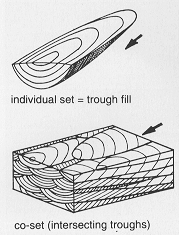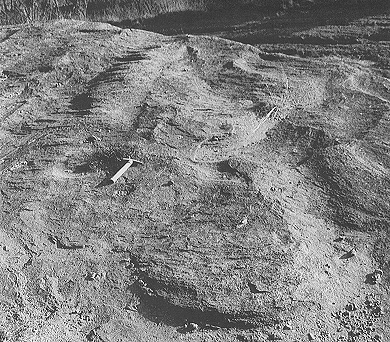

Trough cross-bedding: "horizontal" section
Plate 35


Trough cross-bedding: "horizontal" section
Plate 35
Among the three characteristic sections of cross-bedding, which are mutually perpendicular (see inset), one is parallel to the topographic surface (i.e., horizontal in Modern settings: see commentary below). It contains the current direction (usually indicated by x or a in a spatial frame of three cartesian axes) and the normal on the horizontal plane (z or b ). The current vector coincides (see arrow in sketch, hammer in picture) with the bisectrix of the arc outlined by the intersection of foreset laminae with the horizontal plane (this pattern is also called a rib-and-furrow structure, see plate 94). Compare the sketch with the picture and find out the paleocurrent direction in the outcrop.
The width of the trough (and of the corresponding laminaset) is measured along z.
A horizontal or bed-parallel section is not common; when available, it provides the best opportunities for paleocurrent measurements. This for two reasons: 1) the single reading is more reliable because the geometry of the structure is more evident in this section; 2) multiple measurements can be taken in troughs juxtaposed at the same stratigraphic level.
Pliocene sandstone, Intra-apenninic Basin, Brento, northern Apennines.
To describe the geometry of cross-stratification, reference has been made to the horizontal plane (an approximation of the present topography, at least in depositional environments) and to the vertical or zenith. In tectonically tilted successions, the terms horizontal and vertical must be replaced by parallel and normal to bedding planes, respectively. Reference bedding planes are, in certain cases, ideal surfaces that must be inferred by "averaging" inclined surfaces (for example, plate 34 A) or looking at the general attitude of the stratigraphic succession. Cross-bedded sets can also be bounded by parallel surfaces of higher rank; they are qualified as master bedding and constitute good datum planes. Remember, however, that master bedding is not horizontal in all cases (see clinoforms).